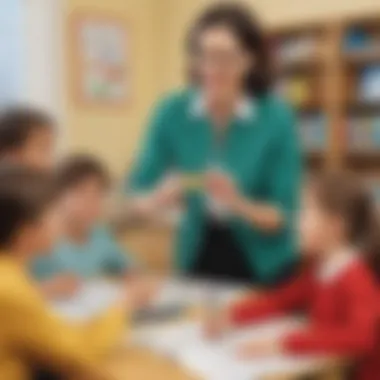Exploring the Importance of Phonics Blends Worksheets


Intro
Phonics blends worksheets have emerged as crucial tools in the realm of early literacy development. They serve not only to bolster phonemic awareness but also to enhance reading skills among young learners. Understanding the role of these worksheets is essential for parents, educators, and caregivers who aim to cultivate literacy in children aged three to twelve. This article delves into the diverse aspects of phonics blends worksheets, exploring their significance, various types, and effective methodologies for implementation.
Interactive Learning Games
Engaging children with playful activities can significantly enhance their learning process. Interactive learning games play a pivotal role in this, providing a dynamic approach to phonics blends and early reading skills.
Popular Games
Certain games stand out among educators and parents for their effectiveness in teaching phonics blends. Games like "Letter Sounds Bingo" and "Phonics Hopscotch" are popular choices. These games make learning enjoyable and interactive, ensuring that children remain engaged.
Description of Top Educational Games
- Letter Sounds Bingo
This game involves matching pictures with corresponding letter sounds. It reinforces phonics concepts while making the activity fun. - Phonics Hopscotch
In this game, children jump on letters or sounds placed on the ground, saying them aloud as they hop. This helps in connecting physical movement with learning.
Benefits of Playing Educational Games for Kids' Cognitive Development
Playing educational games facilitates several cognitive benefits:
- Improved Memory: Associating sounds with visuals helps in strengthening memory.
- Critical Thinking: Many games prompt children to think critically and make quick decisions.
- Social Skills: When played in groups, children develop teamwork and communication skills.
Game Reviews
In-depth evaluations of selected games can provide insights on effectiveness and engagement.
- Letter Sounds Bingo Review: This game received positive feedback for its versatility. It can be customized by changing difficulty levels, making it suitable for various ages.
- Phonics Hopscotch Review: Parents noticed that this game kept children active while learning. It blends physical activity with cognitive skills, which is advantageous.
Comparison of Gameplay and Learning Outcomes
Based on gameplay experience, both games yielded positive learning outcomes. However, Letter Sounds Bingo is more suited for quieter settings, while Phonics Hopscotch excels in outdoor environments. Each offers unique advantages depending on learning context.
Educational Topics
Broader educational topics also tie into phonics blends worksheets. Understanding various subjects aids holistic development in children.
Compilation of Articles Covering Various Subjects
Research on interdisciplinary learning highlights the importance of integrating subjects like math, science, and languages. This strategic approach enhances children's overall cognitive development.
Importance of Interdisciplinary Learning for Holistic Development
Interdisciplinary learning fosters critical thinking and helps children understand connections between various subjects. This comprehensive approach is essential in nurturing well-rounded individuals.
Tips and Tricks
To effectively promote learning, practical tips can help parents and educators.
Practical Tips for Parents and Educators
- Set a Routine: Consistence in learning hours increases effectiveness.
- Show Enthusiasm: Your attitude influences children's perceptions of learning.
Strategies for Making Learning Fun and Engaging
Utilizing creative methodologies can spark children's interest:
- Integrate music and movement in lessons.
- Use colorful visuals and hands-on activities.
Creative DIY Projects
Engaging children in DIY projects can enhance their creativity and comprehension of phonics blends.
Step-by-Step Guides
Detailed instructions for DIY projects not only promote creativity but also serve educational purposes. Simple activities, such as creating a phonics blend poster, can be both fun and educational.
Benefits of Hands-on Activities for Children's Cognitive and Motor Skills
Hands-on activities encourage problem-solving, fine motor skill development, and make learning tangible.


Craft Ideas
Children can create phonics blend crafts using household items such as paper, scissors, and markers. For instance, crafting letter puppets can facilitate phonics sound practice.
Importance of Artistic Expression in Children's Development
Artistic expression nurtures imagination and improves self-esteem. This environment fosters innovative thinking essential for literacy and beyond.
"Hands-on activities and games lay a strong foundation for literacy, engaging children in meaningful learning experiences."
With these insights, the exploration of phonics blends worksheets highlights the merits of an engaging and interactive approach to early literacy, fostering critical skills for young learners.
Understanding Phonics Blends
Phonics blends are a fundamental concept in reading education. They refer to combinations of two or more consonants that yield a unique sound when spoken. For instance, the blend “str” in “street” entails pronouncing the sounds of the letters more closely together than would be typical in separate letter sounds. Understanding phonics blends is crucial for both students and educators alike as it enhances reading abilities and literacy skills.
The significance of phonics blends extends beyond mere pronunciation. They play a vital role in developing phonemic awareness, which is a critical precursor to successful reading. By learning to identify and manipulate these blends, children start to recognize patterns in words, facilitating word recognition. This concept creates a bridge between phonics instruction and reading fluency, enabling young learners to decode words effectively.
Definition of Phonics Blends
Phonics blends are formed when two or more consonants are joined together, with each letter retaining its sound. This allows for the creation of new sounds that appear frequently in the English language. Examples include blends such as "bl," "cl," and "fl." Each of these combinations introduces students to new phonetic structures, enhancing their understanding of how letters interact to form sounds.
By mastering blends, children gain confidence in their reading skills. It empowers them to tackle unfamiliar words with greater ease. This foundational knowledge is essential as it lays the groundwork for more advanced literacy concepts.
Importance in Early Literacy
The importance of phonics blends in early literacy cannot be overstated. As children begin their literacy journey, they confront the challenge of decoding written language. Phonics blends serve as a critical tool in this process. They not only aid in decoding but also contribute to overall reading fluency. With a strong grasp of phonics blends, students can read with more confidence and accuracy.
Moreover, blends foster vocabulary development. As children engage with various texts and practice their reading skills, they encounter new words that often contain blends. This exposure enhances their oral and written vocabulary, enriching their language skills.
In early literacy classrooms, effective use of phonics blends can also motivate students. Engaging worksheets and activities designed around blends help maintain student interest and encourage participation. Educators can utilize these materials to assess understanding and provide targeted instruction, ensuring that all students progress at their own pace.
"Understanding phonics blends is more than a reading skill; it's a stepping stone to unlocking literacy for children."
In summary, the exploration of phonics blends holds great relevance. It provides foundational reading skills while supporting vocabulary development and enhancing overall literacy. Implementing phonics blends effectively in educational contexts can significantly improve children's reading abilities, making it a priority for teachers and caregivers.
Types of Phonics Blends
Understanding the types of phonics blends is essential for effective literacy instruction. Blends are groups of two or more consonants or vowels that produce distinct sounds when pronounced. Recognizing and practicing these blends helps children improve their reading and writing abilities. This section will discuss consonant blends and vowel blends and their implications for early literacy education.
Consonant Blends
Consonant blends consist of two or more consonants combined at the beginning or the end of a word. Each letter retains its sound, allowing children to blend them together to form a word. For instance, in the word "blend," the consonants 'b' and 'l' create the initial blend. The ability to recognize these sounds is crucial since it lays the groundwork for phonetic decoding.
Benefits of practicing consonant blends include:
- Enhanced Phonemic Awareness: Recognizing individual sounds leads to better reading proficiency.
- Increased Vocabulary: As children learn to decode more words, their vocabulary expands.
- Improved Spelling Skills: Knowledge of consonant blends aids in understanding spelling patterns.
Educators can implement various activities, such as sorting and matching exercises, to reinforce consonant blends. These activities keep learners engaged while helping them develop stronger phonics skills.
Vowel Blends
Vowel blends, often referred to as diphthongs and vowel teams, involve the combination of two vowels within a word. In contrast to consonant blends, vowel blends result in a single unique sound or a glide from one vowel to another. For example, in the word "coin," the 'o' and 'i' create a specific sound, making it a vowel blend.
The importance of vowel blends cannot be overstated. They contribute to:
- Reading Fluency: Understanding vowel combinations can lead to smoother reading and speech.
- Decoding Complex Words: Vowel blends often appear in more advanced vocabulary, allowing students to tackle complex texts.
- Supporting Phonological Skills: By mastering vowel combinations, children develop critical skills for overall language comprehension.
Incorporating vowel blends into worksheets can include matching games where students pair words with similar vowel sounds or engage in sorting activities. Such strategies ensure that learning remains interactive and effective.
Components of Blends Worksheets
Phonics blends worksheets serve as a pivotal resource in the journey of early literacy development. These worksheets provide structured opportunities for children to practice blending sounds, which is crucial for reading proficiency. The design and execution of these worksheets play a significant role in making learning effective and engaging.
The components of these worksheets encompass various elements that facilitate learning. Having a clear worksheet structure allows educators to present information systematically. Furthermore, diverse activities based on phonics blends enhance student interaction and retention. Each aspect contributes to the overall efficacy of phonics instruction.
Worksheet Structure
A well-thought-out structure forms the backbone of phonics blends worksheets. Typically, worksheets begin with a clear title and objective. This clarity helps students understand what they will learn. Following this, sections may include explanations of particular phonics blends, visual aids, and sufficient space for writing or drawing.


Incorporating engaging elements is also key. Colorful designs, illustrations, and readability are critical. They keep young learners interested and motivate them to complete the tasks. A logical flow from simpler tasks to more challenging ones allows scaffolding in learning. Thus, the structure of these worksheets not only provides clarity but also builds confidence in kids.
Types of Activities
The activities within phonics blends worksheets are designed to cater to varying learning styles. These activities range from creative exercises to direct applications of knowledge.
Tracing
Tracing is a fundamental activity that targets motor skills along with phonics practice. When kids trace letters and words, they develop both writing skills and familiarity with sound connections. The key characteristic of tracing is its repetitive nature, allowing for reinforcement of learning. This makes tracing a beneficial choice for both home and classroom settings.
An advantage of tracing is the tactile feedback it provides. Children physically engage with the letters, which aids memorization. However, some may find tracing to be too simplistic over time, so it is essential to complement it with other activities to maintain engagement.
Coloring
Coloring activities introduce a visual and creative aspect to learning phonics blends. Kids can color images related to specific blends, which enhances memory retention. The key characteristic of coloring is its ability to make learning enjoyable. It transforms what could be a dry exercise into an exciting task.
This activity fosters creativity while reinforcing learning. There is also the added benefit of relaxation through coloring, as it can have a calming effect. However, if used excessively, it may divert focus from the primary learning objectives.
Matching
Matching activities offer a way for children to make connections between sounds and letters. This exercise can involve pairing pictures with words or matching blends with their corresponding sounds. The key characteristic of matching is its interactive and competitive nature. It encourages kids to think critically and engage with their peers.
The unique feature of matching lies in its visual learning approach. Children can see and link concepts, helping retain information. While it can often be challenging for some learners, when administered in the right context, it can greatly enhance their understanding and vocabulary development.
Benefits of Using Phonics Blends Worksheets
Phonics blends worksheets serve a crucial role in structuring early literacy education. They provide systematic practice in recognizing and creating sounds, which is fundamental for children developing reading skills. The worksheets facilitate the learning of blends, where two or more consonants are combined before or after a vowel to create distinct sounds and words. This method is significant, as it fosters a robust phonics foundation necessary for lifelong literacy.
Enhancing Phonemic Awareness
Phonemic awareness refers to the ability to notice, think about, and work with the individual sounds in spoken words. Through phonics blends worksheets, children engage with sounds by blending them to form words. Exercises that focus on consonant blends, like br, st, or pl, help children break down and manipulate sounds, which is essential for effective reading.
Understanding the relationships between sounds can lead to better retention and recall. Worksheets often include repetition and varied exercises that encourage children to apply their skills in different contexts. This repeated practice is instrumental in reinforcing their learning and improving overall phonemic awareness.
Improving Reading Fluency
Reading fluency involves the ability to read smoothly and effortlessly. Phonics blends worksheets play an integral part in building that fluency. When children learn blends and practice them consistently, they encounter familiar patterns in words, which makes reading easier. As their familiarity grows, they can decode new words more quickly.
Incorporating timed reading sessions or guided reading practices using these worksheets can significantly enhance reading speed and confidence. As children transition from sounding out words to reading them with ease, their joy and interest in reading often increase.
Supporting Vocabulary Development
Phonics blends worksheets not only aid in recognizing sounds but also play a role in developing a rich vocabulary. When children practice with blends, they begin to see words in a new light. This exposure can broaden their word bank.
Worksheets often include matching activities or illustrations that connect words to images. Such activities encourage children to associate words with meanings, enhancing their comprehension. Moreover, a good vocabulary is vital for understanding language nuances, which aligns with their overall literacy development.
"Effective use of phonics blends worksheets can vastly improve both reading comprehension and language use in young learners."
By emphasizing these benefits, parents and educators can better understand how phonics blends worksheets contribute to literacy. Their strategic use in educational settings supports a comprehensive approach to learning essential reading skills.
Implementing Phonics Blends Worksheets
The implementation of phonics blends worksheets represents a crucial phase in aiding early literacy skills. Effective incorporation of these tools facilitates not just rote learning but also deepens understanding in children. Phonics blends worksheets serve as the bridge between phonemic awareness and actual reading proficiency. When executed correctly, they can significantly elevate a child's reading ability while providing a structured yet flexible learning environment.
Adaptation for Different Learning Levels
Not every child learns at the same speed or in the same way. Therefore, adaptation of phonics blends worksheets is essential. Children bring various backgrounds, experiences, and learning abilities to the educational setting. Teachers and parents must recognize these differences to tailor materials that meet individual needs.
- Differentiation in Activities:
- Adjusting Presentation:
- Flexible Pacing:
- For advanced learners, worksheets can include more complex blends, encouraging exploration of longer words.
- Struggling readers may benefit from simplified worksheets that focus solely on two or three-letter blends.
- Visual aids, like pictures corresponding to words, help those who need more graphical representations.
- Kinesthetic activities, such as letter blocks or writing in sand, are effective for tangible learners.
- Giving students the choice to work at their own pace can take the pressure off and promote confidence.
- Regular assessments allow educators to adjust the difficulty of tasks and provide required support.
Implementing these adaptations fosters inclusion, which is essential in diverse classrooms.
Integrating into Lesson Plans


The integration of phonics blends worksheets into lesson plans is another critical aspect. Effectively aligned classroom activities can enhance overall learning and retention. Here are some strategies to consider:
- Structured Routine: Incorporate worksheets as part of daily reading routines. This strengthens reading as a habit.
- Cross-Disciplinary Approach: Use phonics blends as a stepping stone in other subjects. For instance, blending can link art and language through labeling art supplies, enhancing vocabulary.
- Group Activities: Implement cooperative learning strategies. Small groups can work on worksheets together, helping each other understand the material.
"Incorporating phonics blends worksheets into diverse lesson plans enriches students' overall learning experiences. It builds a comprehensive grasp of language while maintaining engagement and interest."
- Assessment and Feedback: Regularly assess student progress using the worksheets. Feedback from these assessments should be constructive to guide future lessons effectively.
In summary, thoughtful implementation of phonics blends worksheets—tailored for various learning levels and seamlessly integrated into lesson plans—can harness their potential in fostering effective literacy development. This careful approach not only benefits the learners but also promotes an enriched teaching environment.
Challenges in Using Phonics Blends Worksheets
When incorporating phonics blends worksheets in educational settings, various challenges can arise. These challenges can hinder the effectiveness of the worksheets and their intended impact on early literacy development. Addressing these challenges is crucial for ensuring that phonics instruction meets the diverse needs of learners. This section delves into the specific difficulties associated with using phonics blends worksheets and offers insights into how to navigate these obstacles.
Diverse Learning Needs
Every classroom comprises students with different learning styles, paces, and preferences. Young learners may vary widely in their phonemic awareness and comprehension skills. Some children might grasp blends quickly, while others may struggle with even basic sounds. This diversity means that a one-size-fits-all approach to phonics blends worksheets is often ineffective.
To address these diverse learning needs, educators can consider the following:
- Differentiated Instruction: Tailor worksheets to suit varying levels of proficiency. Creating different sets of worksheets for advanced learners, beginners, and those who need additional support can ensure that every child engages meaningfully with the material.
- Scaffolding Techniques: Gradually introduce phonics blends, allowing students to build on their existing knowledge. Break down complex sounds into simpler components, providing ample practice before moving to more advanced blends.
- Interactive Elements: Incorporate hands-on activities that complement the worksheets. For example, using manipulatives or digital tools can cater to kinesthetic learners and those who learn better through visual or auditory input.
Resource Availability
Another challenge that educators and parents may face is the availability of quality resources. While many phonics blends worksheets are accessible online, not all are suitable or effective for teaching. Some may lack engaging content or proper alignment with learning objectives. Additionally, various educational systems or individual schools may have budget limitations, which can restrict access to various teaching materials.
To overcome resource availability issues, consider these strategies:
- Utilizing Online Platforms: Websites like en.wikipedia.org and britannica.com offer valuable insights into phonics and general literacy education. These can complement the worksheets being used and provide additional context and ideas.
- Creating Custom Resources: Educators can design tailored worksheets that specifically meet the needs of their students. This could include incorporating familiar themes, vocabulary, and visuals that resonate with the children.
- Collaborating with Other Educators: Sharing resources and ideas with fellow teachers can enhance the overall quality of phonics instruction. Collaboratively creating a bank of worksheets can increase resource availability and improve teaching effectiveness.
"Addressing the challenges related to diverse learning needs and resource availability enhances the effectiveness of phonics instruction and fosters a supportive learning environment."
Resources for Phonics Blends Worksheets
Accessing quality resources for phonics blends worksheets is crucial for anyone involved in teaching young children. These resources not only help educators deliver effective instruction but also support parents and caregivers in reinforcing literacy skills at home. The availability of diverse resources ensures that learning remains engaging and tailored to children's needs.
Online Platforms
Online platforms offer a rich variety of phonics blends worksheets readily available for teachers and caregivers. Websites like Teachers Pay Teachers and Education.com provide a plethora of downloadable content. This content includes insightful lesson plans, engaging exercises, and customizable worksheets that can meet the requirements of different learning environments. The interactivity possible on these platforms can make learning more appealing. Here are several benefits to exploring online resources:
- Variety of Materials: Online platforms typically feature a wide range of worksheets catering to various skill levels.
- Ease of Access: Many worksheets are just a click away. It reduces the need for extensive searching.
- Customization Options: Some platforms allow users to edit or create worksheets tailored to individual student needs.
Educators and parents should also consider user reviews and ratings on these platforms to ensure quality. Utilizing online resources can transform worksheet exercises into a dynamic part of literacy instruction.
Printable Worksheets
Printable worksheets represent another important resource for phonics blends. They provide tangible materials that can be used during class or at home. These worksheets can be printed and distributed easily, making them highly practical.
Free resources available through sites like en.wikipedia.org and britannica.com can be especially useful for printable worksheets. They often contain structured phonics blends activities that enhance the learning experience. Here is why printable worksheets are indispensable:
- Hands-On Learning: Children can physically write, color, or cut out parts of worksheets, which can enhance their engagement.
- Focus on Specific Skills: Certain printable worksheets are designed to target phonemic awareness, ensuring focused instruction.
- Offline Accessibility: Unlike online platforms, printed materials can be used without needing internet access, which is beneficial in various settings.
Utilizing a combination of online platforms and printable worksheets provides a comprehensive toolkit for effective phonics instruction. In this way, both parents and educators can contribute positively to a child’s literacy development.
Future Directions in Phonics Education
The landscape of phonics education is evolving. As we consider the future of phonics blends worksheets, it is essential to look at emerging trends that could reshape early literacy teaching methods. Innovations in educational technology and shifts in research focus are guiding educators toward more effective and engaging teaching strategies. Understanding these new directions can enhance teaching practices, benefitting both educators and learners.
Technological Advances in Learning Tools
Technology is playing a critical role in the education sector. In phonics education, various digital tools are enhancing the way children learn and interact with phonics blends. Applications and online platforms provide interactive experiences where children can engage in phonics practice at their own pace.
Key advantages include:
- Personalized Learning: Tools adapt to the learner's level, providing customized exercises that cater to individual proficiency.
- Immediate Feedback: Children receive instant feedback on their performance, helping them understand their mistakes and learn continuously.
- Engagement through Gamification: Many applications integrate gamification elements, making learning phonics fun and motivating for young learners.
Moreover, educators can utilize online platforms to access a wealth of resources. They can find or create blended worksheets that align with specific learning objectives, making it easier to incorporate phonics instruction into their curricula.
Research Trends in Phonics Instruction
Research in phonics education emphasizes the importance of evidence-based practices. Ongoing studies are focusing on how various instructional strategies impact phonics understanding and word recognition. Emerging research findings guide how educators structure their classrooms and use phonics blends effectively.
Significant trends include:
- Focus on Phonemic Awareness: Research indicates that strong phonemic awareness is foundational to reading success. Instructional strategies that prioritize this aspect are becoming more common.
- Integration of Multisensory Approaches: Studies suggest that multisensory instruction—engaging visual, auditory, and kinesthetic modalities—can enhance learning outcomes in phonics.
- Data-Driven Instruction: Using assessment data to inform instruction helps teachers identify areas where students struggle. It allows for targeted interventions based on specific needs.
"As we explore the future of phonics education, staying updated with research findings is crucial for effective instruction."















